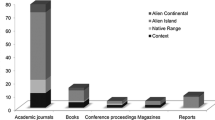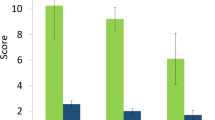Abstract
Eradication of alien plants is notoriously challenging, however eradication projects reap great biodiversity benefits, particularly on islands. To date only individual plants or small restricted populations have been successfully eradicated from the Southern Ocean Islands (SOI). The next phase in conservation for the region is tackling more widespread, abundant alien plant species. Several on-going and proposed control programs for such weeds exist in the SOI and Antarctic regions. If eradication of a widespread species is to be successful, a number of factors need to be considered. ‘Organisational’ factors such as management agency capacity, resources and the availability of effective control methods are critical to the success of an eradication. ‘Site and species’ factors such as infestation extent, number of discrete populations, dispersal processes and detectability typically show a cumulative effect on success. We assessed the site and species factors for Stellaria media, an alien species on sub-Antarctic Macquarie Island, to determine the feasibility of its eradication from the island. Organisational factors can successfully be met with adequate funding. Site and species factors which reduce the likelihood of eradication included large gross infestation areas, large plants with high reproductive output (precocity or fecundity), dense seed banks, short pre-reproductive period, extended seed longevity and vegetative reproductive capacity. We recommend a small-scale eradication trial for restricted, easily accessible populations of S. media on Macquarie Island to further evaluate the likelihood of broader eradication.

Similar content being viewed by others
References
Alaska Center for Conservation Science—University of Alaska Anchorage (unknown) Common chickweed Stellaria media (L.) Vill. http://accs.uaa.alaska.edu/files/invasive-species/Stellaria_media_BIO_STME2.pdf
Australian Antarctic Division (2015). http://www.antarctica.gov.au/living-and-working/predeparture/biosecurity. Accessed 1 July 2017
Australian Bureau of Meteorology (2016) Climate of Macquarie Island. Australian Government, Bureau of Meteorology. http://www.bom.gov.au/ant/macquarie/climate.shtml. Accessed 10 Jan 16
Bond W, Davies G, Turner R (2007) The biology and non-chemical control of common chickweed (Stellaria media L.). The Organic Organisation. https://www.gardenorganic.org.uk/sites/www.gardenorganic.org.uk/files/organic-weeds/stellaria%20media.pdf. Accessed 20 July 2018
Cacho O, Spring D, Pheloung P, Hester S (2006) Evaluating the feasibility of eradicating an invasion. Biol Invasions 8:903–917
Caut S, Angulo E, Courchamp F (2009) Avoiding surprise effects on Surprise Island: alien species control in a multitrophic level perspective. Biol Invasions 11:1169–1703. https://doi.org/10.1007/s10530-008-9397-9
Cherry H, Constantine A, Primrose K, Hauser C, Tasker K (2016) It takes a village: detection dogs, partnerships and volunteers aid hawkweed eradication in mainland Australia. In: 20th Australasian Weeds conference, Perth, 2016. Weeds Society of WA Inc., Perth, pp 164–170
Clavero M, Garcia-Berthou E (2005) Invasive species are a leading cause of animal extinction. Trends Ecol Evol 20:110
Convey P, Chown SL, Wasley J, Bergstrom DM (2006) Life history traits. Trends in antarctic terrestrial and limnetic ecosystems. Springer, Netherlands. https://doi.org/10.1007/1-4020-5277-4_6
Copson GR (1984) An annotated atlas of the vascular flora on Macquarie Island. ANARE Res Notes 18:1–70
Copson G, Whinam J (2001) Review of ecological restoration programme on subantarctic Macquarie Island: pest management progress and future directions. Ecol Manag Restor 2:129–138. https://doi.org/10.1046/j.1442-8903.2001.00076.x
Defelice M (2004) Common chickweed, Stellaria media (L.) Vill.—”Mere Chicken Feed?”. Weed Technol 18:193–200
Department of Conservation (2017) https://www.doc.govt.nz/our-work/. Accessed 1 July 2017
Department of Primary Industries, Parks, Water and Environment (unpublished data)
Dodd AJ, Ainsworth N, Burgman MA, McCarthy MA (2015) Plant extirpation at the site scale: implications for eradication programmes. Divers Distrib 21:151–162. https://doi.org/10.1111/ddi.12262
Ellis WM, Lee BTO, Calder DM (1971) A biometric analysis of populations of Poa annua L. Evolution 25:29–37. https://doi.org/10.2307/2406497
Frenot Y, Gloaguen JC, Masse L, Lebouvier M (2001) Human activities, ecosystem disturbance and plant invasion in subantarctic Crozet, Kerguelen and Amsterdam Islands. Biol Cons 101:33–50. https://doi.org/10.1016/S0006-3207(01)00052-0
Frenot Y, Chown SL, Whinam J, Selkirk PM, Convey P, Skotnicki M, Bergstrom DM (2005) Biological invasions in the Antarctic: extent, impacts and implications. Biol Rev Camb Philos Soc 80:45–72. https://doi.org/10.1017/S1464793104006542
Genovesi P (2011) Eradication. In: Simberloff D, Rejmanek M (eds) Encyclopedia of biological invasions. University of California Press, Berkeley, pp 198–203
Government of South Georgia and the South Sandwich Islands (2016) South Georgia non-native plant management strategy 2016–2020. Government House, Stanley
Gremmen NJM, Smith VR (1999) New records of alien vascular plants from Marion and Prince Edwards Islands, sub-Antarctic. Polar Biol 21:401–409
Greve M, Mathakutha R, Steyn C, Chown SL (2017) Terrestrial invasions on sub-Antarctic Marion and Prince Edward Islands. Bothalia 47:a2143
Groves R, Panetta F (2002) Some general principles for weed eradication programs. In: Spafford Jacob H, Dodd J, Moore J (eds) Papers and proceedings of the 13th Australian Weed conference, Perth, 2002. Plant Protection Society of WA Inc., Perth, pp 307–310
Hussner A, Windhaus M, Starfinger U (2016) From weed biology to successful control: an example of successful management of Ludwigia grandiflora in Germany. Weed Res 56:434–441. https://doi.org/10.1111/wre.12224
Jones H et al (2016) Invasive mammal eradication on islands results in substantial conservation gains. Proc Nat Acad Sci United States Am 113:4033–4038
le Roux PC et al (2013) Human activities, propagule pressure and alien plants in the sub-Antarctic: tests of generalities and evidence in support of management. Biol Cons 161:18–27. https://doi.org/10.1016/j.biocon.2013.02.005
McClelland GTW, Altwegg R, van Aarde R, Ferreira S, Burger A, Chown SL (2018) Climate change leads to increasing population density and impacts of a key island invader. Ecol Appl 28:212–224
McGeoch MA, Shaw JD, Terauds A, Lee JE, Chown SL (2015) Monitoring biological invasion across the broader Antarctic: a baseline and indicator framework. Glob Environ Change 32:108–125. https://doi.org/10.1016/j.gloenvcha.2014.12.012
Moody ME, Mack RN (1988) Controlling the spread of plant invasions: the importance of nascent foci. J Appl Ecol 25:1009–1021. https://doi.org/10.2307/2403762
Myers JH, Simberloff D, Kuris AM, Carey JR (2000) Eradication revisited: dealing with exotic species. Trends Ecol Evol 15:316–320
Panetta F, Timmins S (2004) Evaluating the feasibility of eradication for terrestrial weed incursions. Plant Prot Q 19:5–11
Parkes JP, Panetta FD (2009) Eradication of invasive species: progress and emerging issues in the 21st century. In: Clout M, Williams P (eds) Invasive species management: a handbook of principles and techniques. Techniques in ecology and conservation series. Oxford University Press, Oxford, pp 47–62
Parks and Wildlife Service (2006) Macquarie Island Nature Reserve and World Heritage Area Management Plan. Parks and Wildlife Service. Department of Tourism, Arts and the Environment, Hobart
Peters J (ed) (2000) Tetrazolium Testing Handbook: Contribution No. 29 to the Handbook on Seed Testing, revised 2000. AOSA, Las Cruces
Rejmánek M, Pitcairn M (2002) When is eradication of exotic pest plants a realistic goal? In: Veitch C, Clout M (eds) Turning the tide: the eradication of invasive species. IUCN SSC Invasive Species Specialist Group, Gland
Roberts HA, Feast PM (1973) Emergence and longevity of seeds of annual weeds in cultivated and undistrubed soil. J Appl Ecol 10:133–143. https://doi.org/10.2307/2404721
Royal Society for the Protection of Birds (2017) https://www.rspb.org.uk/. Accessed 1 July 2017
Selkirk P, Seppelt R, Selkirk D (1990) Subantarctic Macquarie Island: environment and biology. Cambridge University Press, Cambridge
Shaw J (2013) Southern ocean islands invaded: Conserving biodiversity in the world’s last wilderness. In: Foxcroft L, Pysek P, Richardson D, Genovesi P (eds) Plant invasions in protected areas: patterns, problems and challenges. Springer, Berlin, pp 449–472
Simberloff D (2002) Today Tiritiri Matangi, tomorrow the world! Are we aiming too low in invasives control? In: Veitch C, Clout M (eds) Turning the tide: the eradication of invasive species. IUCN, SSC Invasive Species Specialist Group, Gland, pp 4–12
Simberloff D (2003) Eradication—preventing invasions at the outset. Weed Sci 51:247–253
Simberloff D (2013) Eradication: Pipe dream or real option? In: Foxcroft L, Pysˇek P, Richardson D, Genovesi P (eds) Plant invasions in protected areas: patterns, problems and challenges. Springer, Berlin, pp 549–560
Simberloff D (2014) Biological invasions: what’s worth fighting and what can be won? Ecol Eng 65:112–121. https://doi.org/10.1016/j.ecoleng.2013.08.004
Simberloff D et al (2013) Impacts of biological invasions: what’s what and the way forward. Trends Ecol Evol 28:58–66. https://doi.org/10.1016/j.tree.2012.07.013
Sindel BM, Kristiansen PE, Wilson S, Shaw J, Williams L (2018) Managing invasive plants on sub-Antarctic Macquarie Island. Rangel J 39:537–549
Sobey D (1981) Stellaria media (L.) Vill. J Ecol 69:311–335
South Georgia Heritage Trust (2017). http://www.sght.org/. Accesed 1 July 2017
Tershy B, Shen K-W, Newton K, Holmes N, Croll D (2015) The importance of islands for the protection of biological and linguistic diversity. Bioscience 65:592–597
Turkington R, Kenkel N, Franko G (1980) The biology of Canadian weeds. 42. Stellaria media (L). Vill. Can J Plant Sci 60:981–992
Walton DWH (1975) European weeds and other alien species in the sub-Antarctic. Weed Res 15:271–282. https://doi.org/10.1111/j.1365-3180.1975.tb01135.x
Williams L, sindle B, Kristiansen K, Wilson S, Shaw J (2019) Assessing the efficacy and impact of management of an invasive - species in a protected area: Poa annua on subAntarctic Macquarie Island. Weed Res (in press)
Zavaleta ES, Hobbs R, Mooney H (2001) Viewing invasive species removal in a whole-ecosystem context. Trends Ecol Evol 16:454–459
Funding
Funding for this project was provided by The University of New England and the Australian Antarctic Division, project AAS 4341. Access to Macquarie Island was provided by the Tasmanian Parks and Wildlife Service and logistical support was provided by the Australian Antarctic Division, Department of the Environment and Energy.
Author information
Authors and Affiliations
Corresponding author
Electronic supplementary material
Below is the link to the electronic supplementary material.
Rights and permissions
About this article
Cite this article
Williams, L.K., Fergus, A.J., Shaw, J.D. et al. Quantifying site and species factors to inform the feasibility of eradication of alien plants from Southern Ocean Islands: Stellaria media on Macquarie Island. Biol Invasions 21, 993–1005 (2019). https://doi.org/10.1007/s10530-018-1880-3
Received:
Accepted:
Published:
Issue Date:
DOI: https://doi.org/10.1007/s10530-018-1880-3




